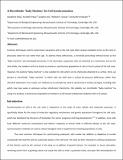| dc.contributor.author | Shaw, Josephine | |
| dc.contributor.author | Payer, Kristofor Robert | |
| dc.contributor.author | Son, Sungmin | |
| dc.contributor.author | Grover, William H. | |
| dc.contributor.author | Manalis, Scott R | |
| dc.date.accessioned | 2014-11-03T14:59:24Z | |
| dc.date.available | 2014-11-03T14:59:24Z | |
| dc.date.issued | 2012-04 | |
| dc.date.submitted | 2012-03 | |
| dc.identifier.issn | 1473-0197 | |
| dc.identifier.issn | 1473-0189 | |
| dc.identifier.uri | http://hdl.handle.net/1721.1/91265 | |
| dc.description.abstract | Common techniques used to synchronize eukaryotic cells in the cell cycle often impose metabolic stress on the cells or physically select for size rather than age. To address these deficiencies, a minimally perturbing method known as the “baby machine” was developed previously. In the technique, suspension cells are attached to a membrane, and as the cells divide, the newborn cells are eluted to produce a synchronous population of cells in the G1 phase of the cell cycle. However, the existing “baby machine” is only suitable for cells which can be chemically attached to a surface. Here, we present a microfluidic “baby machine” in which cells are held onto a surface by pressure differences rather than chemical attachment. As a result, our method can in principle be used to synchronize a variety of cell types, including cells which may have weak or unknown surface attachment chemistries. We validate our microfluidic “baby machine” by using it to produce a synchronous population of newborn L1210 mouse lymphocytic leukemia cells in G1 phase. | en_US |
| dc.description.sponsorship | National Cancer Institute (U.S.). Physical Sciences-Oncology Center (U54CA143874) | en_US |
| dc.description.sponsorship | National Institute of General Medical Sciences (U.S.) (EUREKA R01GM085457) | en_US |
| dc.language.iso | en_US | |
| dc.publisher | Royal Society of Chemistry, The | en_US |
| dc.relation.isversionof | http://dx.doi.org/10.1039/c2lc40277g | en_US |
| dc.rights | Creative Commons Attribution-Noncommercial-Share Alike | en_US |
| dc.rights.uri | http://creativecommons.org/licenses/by-nc-sa/4.0/ | en_US |
| dc.source | Prof. Manalis via Howard Silver | en_US |
| dc.title | A microfluidic “baby machine” for cell synchronization | en_US |
| dc.type | Article | en_US |
| dc.identifier.citation | Shaw, Josephine, Kristofor Payer, Sungmin Son, William H. Grover, and Scott R. Manalis. “A Microfluidic ‘baby Machine’ for Cell Synchronization.” Lab Chip 12, no. 15 (2012): 2656. | en_US |
| dc.contributor.department | Massachusetts Institute of Technology. Department of Biological Engineering | en_US |
| dc.contributor.department | Massachusetts Institute of Technology. Department of Mechanical Engineering | en_US |
| dc.contributor.department | Massachusetts Institute of Technology. Microsystems Technology Laboratories | en_US |
| dc.contributor.department | Koch Institute for Integrative Cancer Research at MIT | en_US |
| dc.contributor.approver | Manalis, Scott R. | en_US |
| dc.contributor.mitauthor | Shaw, Josephine | en_US |
| dc.contributor.mitauthor | Payer, Kristofor Robert | en_US |
| dc.contributor.mitauthor | Manalis, Scott R. | en_US |
| dc.contributor.mitauthor | Grover, William H. | en_US |
| dc.contributor.mitauthor | Son, Sungmin | en_US |
| dc.relation.journal | Lab on a Chip | en_US |
| dc.eprint.version | Author's final manuscript | en_US |
| dc.type.uri | http://purl.org/eprint/type/JournalArticle | en_US |
| eprint.status | http://purl.org/eprint/status/PeerReviewed | en_US |
| dspace.orderedauthors | Shaw, Josephine; Payer, Kristofor; Son, Sungmin; Grover, William H.; Manalis, Scott R. | en_US |
| dc.identifier.orcid | https://orcid.org/0000-0001-5223-9433 | |
| dc.identifier.orcid | https://orcid.org/0000-0003-3415-3614 | |
| mit.license | OPEN_ACCESS_POLICY | en_US |
| mit.metadata.status | Complete | |
